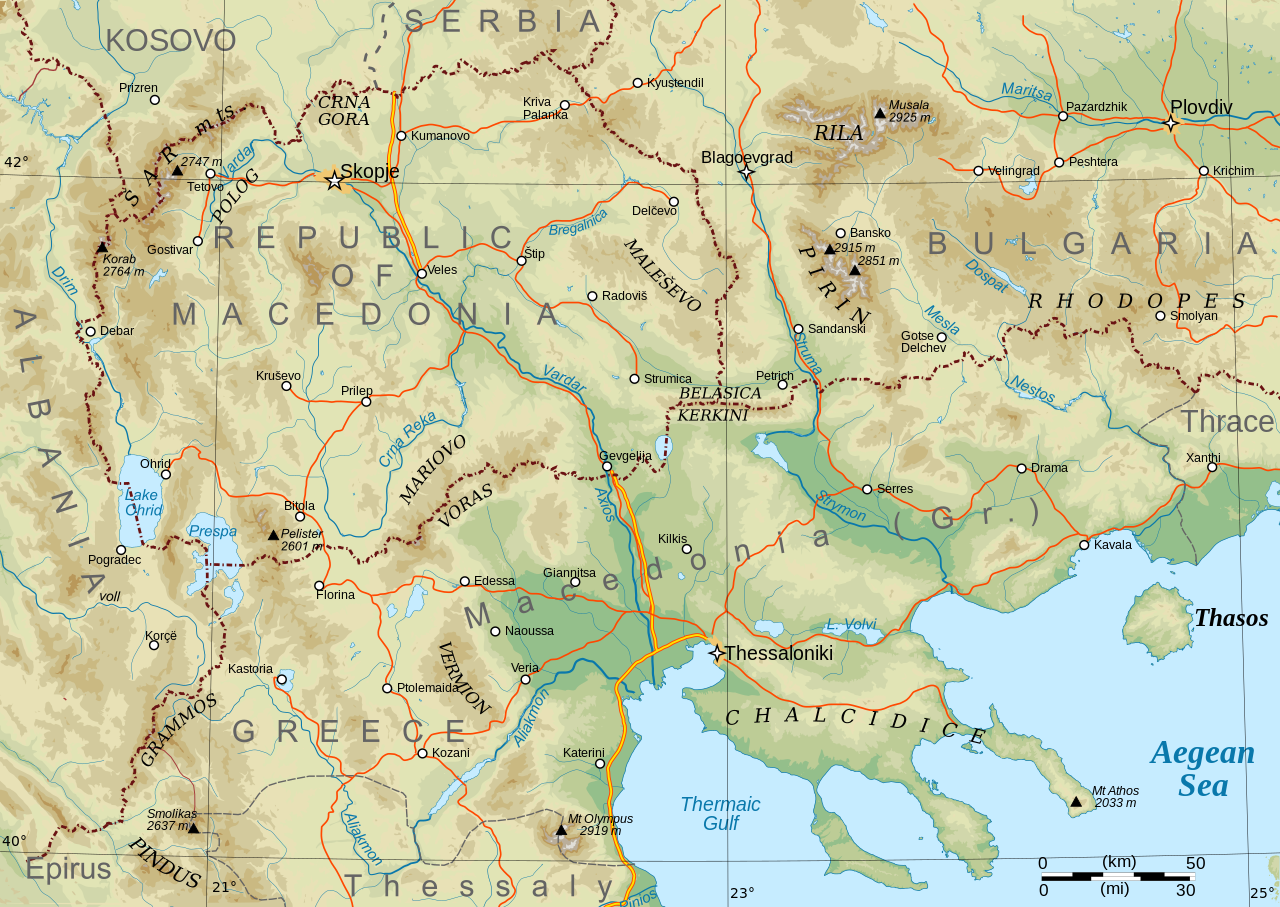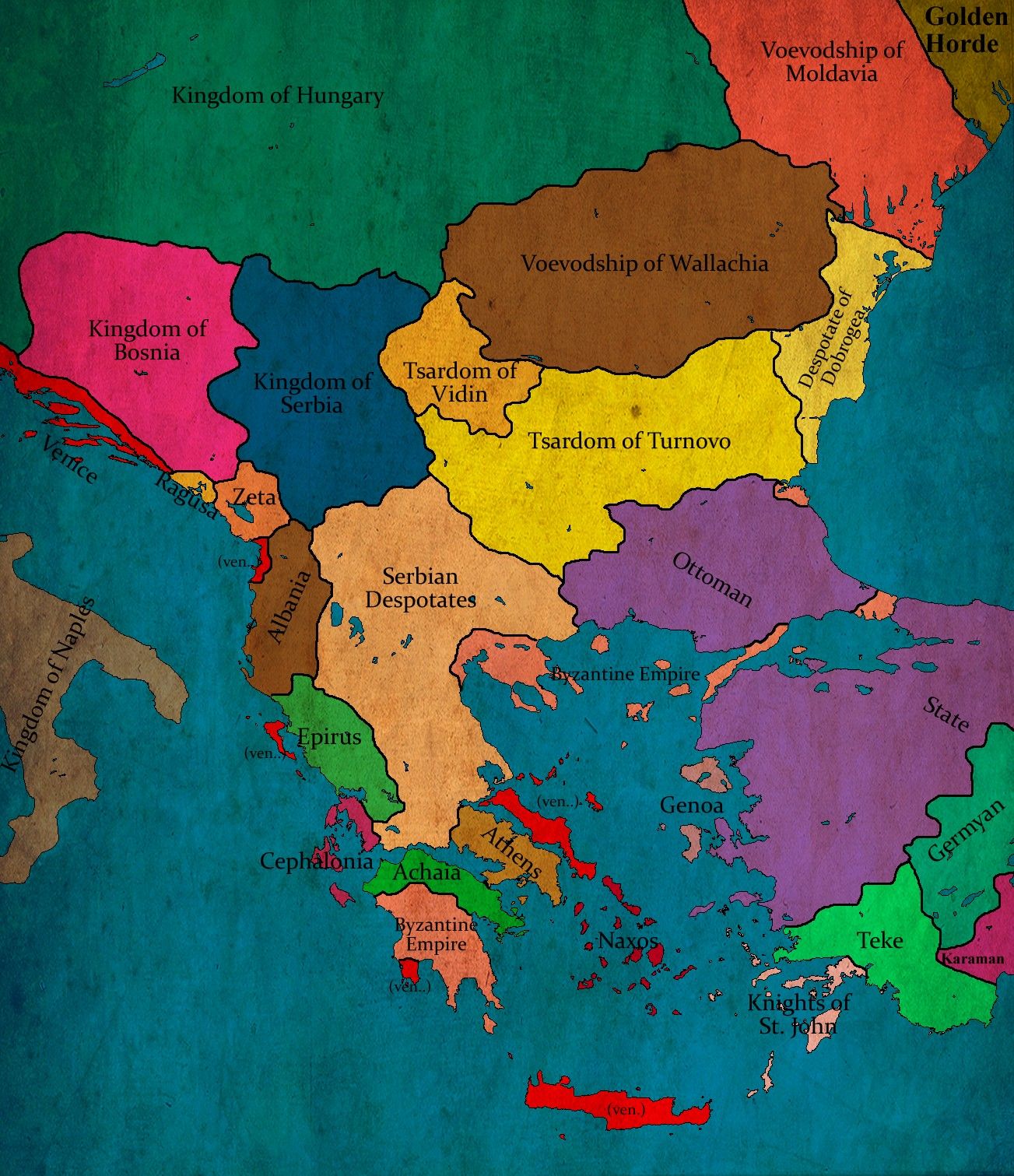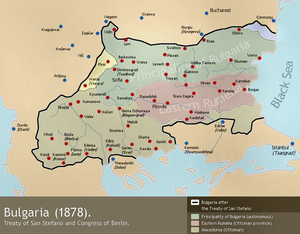More languages
More actions
This article has yet to be finished. Despite the amount of information available, this article is nowhere near complete. Feel free to check in every now and then to see the new updates. |

Macedonia is a region comprised of the Republic of Northern Macedonia as well as the Macedonia district of Greece and parts of Bulgaria, Serbia and Albania.
History
Ancient and Medieval times (808 BC – c. 1500 AD)
In the ancient times, the region was, for the most part, controlled by the Kingdom of Macedonia.
After the Macedonian Empire broke up, the rump state formed was fully conquered and controlled by the Roman Empire, of which it became a province,[1] and then the Byzantine Empire (in which it was part of the Thrace province/thema until the late 8th century)[2] until the late 7th century, when large parts of it got occupied by Slavic tribes and later, in the late 9th century, by the Bulgarian Empire, which occupied all of Macedonia except the town of Thessaloniki and the respective peninsula.
After Bulgaria gradually lost lands and eventually got fully annexed back into Byzantium in 1018, the region came under the latter's full control once again. This was until the Third Crusade, when parts of the region got conquered by the Serbian and Bulgarian empires respectively. After the Fourth Crusade, the European territories of Byzantium (including Macedonia) were controlled by the Latin Empire but slowly got absorbed into the Empire of Nicaea, a rump state of Byzantium, which got re-established after the re-conquest of Constantinople in 1262.

After its re-establishment, Byzantium still controlled most of Macedonia, although this control was gradually lost over the course of the 14th and early 15th century. Initially absorbed into the Serbian and Bulgarian empires in the 14th century, the territory later became a part of the Ottoman Empire, as Serbia and Bulgaria got under Byzantine control.[3]
Ottoman Empire and Balkan Wars (c. 1500 AD - 1912)
During the Ottoman Empire's rule, all of the Macedonian region stayed under Ottoman control until the Balkan Wars. During this time, the name "Macedonia" was rarely ever used.[4][5][6]

During later years, after the Russo-Turkish War of 1877–1878, the Treaty of San Stefano was signed between Russia and the Ottomans where a de jure autonomous but de facto independent state of Bulgaria was to be established, controlling most of Macedonia. [7][8]
The state got established during the Berlin Congress, but with much smaller borders.
Modern Times (1912 - Today)
Balkan Wars and Prelude to the First World War (1912 - 1914)
A coalition between Greece, Serbia, Montenegro and Bulgaria (which declared its full independence in 1908) got formed in 1912.[9]
The league, backed by the Triple Entente, won the war and most Ottoman European lands and thus Macedonia got partitioned between the League and a new Albanian state in the west.
However, Bulgaria attacked Serbia's Macedonian lands in 1913, and a new coalition between Serbia, Montenegro, Greece and Romania was formed, while the Ottoman Empire also attacked Bulgaria, without, however, directly allying with the new coalition. This coalition won and as a result Bulgaria lost territories, including most of Macedonia.
First World War (1914 - 1918)
Interwar Period (1918 - 1939)
World War Two (1939 - 1945)
Cold War, Yugoslavia and the Early Macedonian Naming Dispute (1945-1991)
Macedonian Naming Dispute (1991-2018)
- ↑ Entangled Histories of the Balkans: Volume One, Roumen Daskalov, Tchavdar Marinov, BRILL, 2013, Template:ISBN, pp. 278–279.
- ↑ The migrations during the early Byzantine centuries also changed the meaning of the geographical term Macedonia, which seems to have moved to the east together with some of the non-Slavic population of the old Roman province. In the early 9th century an administrative unit (theme) of Makedonikon was established in what is now Thrace (split among Bulgaria, Greece, and Turkey) with Adrianopleas its capital. It was the birthplace of Emperor Basil I (867–886), the founder of the so-called Macedonian dynasty in Byzantinum. Historical Dictionary of the Republic of Macedonia, Dimitar Bechev, Scarecrow Press, 2009, Template:ISBN, p. Iii.
- ↑ Cottereau. "The History of Europe: Every Year". YouTube.
- ↑ The ancient name 'Macedonia' disappeared during the period of Ottoman rule and was only restored in the nineteenth century originally as geographical term. The Oxford Handbook of the History of Nationalism, John Breuilly, Oxford University Press, 2013, Template:ISBN, p. 192.
- ↑ “However, in the nineteenth century the term Macedonian was used almost exclusively to refer to the geographic region”
History of the Balkans, Vol. 2: Twentieth Century (1983) (pp. 91). Cambridge University Press. ISBN 0521274591 - ↑ “Neuerdings hat man sich wiederum gewöhnt, den Namen M. im Sinne der Alten, d. h. für das jetzige Wilajet Saloniki und den Süden des Wilajets Monastir, zu gebrauchen.”
Mazedonien, vol. 13 (1905) (Macedonia). Zeno.org. - ↑ Where Nation-States Come From: Institutional Change in the Age of Nationalism (2007) (pp. 17–18). Princeton University Press. ISBN 978-0-691-13467-3
- ↑
- REDIRECT Template:Cite
- ↑ Wars of the World: First Balkan War 1912–1913 (December 16, 2000). OnWar.com.
